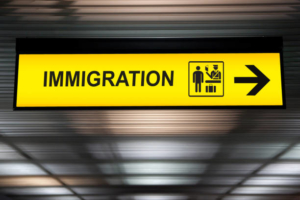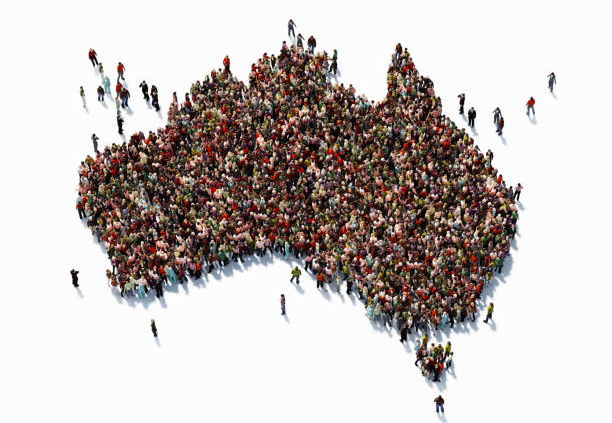Population Growth And The Housing Shortage
Australia is an expansive, wide-open country; it’s bloody huge. We are the ninth most sparsely populated country in the world (the first is Greenland). Of our entire population, 9 out of every 10 people exist on 3% of the land. A multitude of our people lives near the coast. This is because the majority of our inland is a harsh desert. A staggering 80% of our inhabitants reside in the country’s southeast. In a sense, Australia is like an enormous boomerang-shaped slice of toast, where the only edible part is the crust. Australia presents the illusion of endless living space. Given that we’re squeezed into packed cities in the coastal regions, how much space do we have left? With migration tipped to resume again full-tilt post-COVID, the impact will be felt as our cities grow denser. Will we have enough housing or will there be a housing shortage?
Migration And Housing

Australia has a population of 25,604,700, spread across 7.69 square kilometres of beautiful sunburnt terrain. The bulk of that landmass is dry, arid, and flat. This makes it one of the driest and thirstiest spaces on our blue planet. It’s a bugger of a place for your car to break down. That’s why we prefer to live in the cities that hug our vast coastlines. But consider this—during the period of Federation in 1901, the census tallied the Australian population at 3,773,801. We’ve grown a hell of a lot since then with the highest population spike occurring between 2001-and 2016. Former Prime Minister John Howard was responsible for boosting immigration and importing foreign students. This fact blows the myth of a conservative disdain for immigration. But did he screw us?
The big Australia that successive governments have sought is limited by uninhabitable space. Governments and businesses have accelerated migration without strong policies on housing and infrastructure. They tout what they say are the benefits, without considering the pitfalls. And the migrants have kept coming. The overseas student industry provides an alternate road to permanent residency outside of the migration quota. In recent years, pre-pandemic, this has invited unfettered overseas investment in our property market. Immigrants, like the rest of us, tend to gravitate to major cities. All of these factors have created a housing shortage and driven up rents. It has also contributed to the housing bubble, putting housing affordability out of reach for most young Australians. Meanwhile, housing development has been kept to a bare minimum. This hasn’t stopped ambitious plans for microcities centred around transport hubs connected to universities. One such example is the Aerotropolis in Western Sydney.
Exhausting Greenfield Land

In our largest cities, where housing prices are out of control, first-time homebuyers are unable to compete. In addition, COVID has made a significant impact. As a result, there has been a mass exodus to neighbouring states and regional areas. Following lockdowns and fears of contagion, many people are looking for a break from the big smoke. Others are fleeing the state. However, greenfield land is rapidly running out. Sydney and Melbourne are fast exhausting their land reserves. First-time buyers may struggle to afford housing in the outer areas when those changes hit. This has driven up the price of vacant land and impacted its supply. The Victorian division of the Urban Development Institute of Australia commissioned a report on the situation. According to that paper, greenfield land would be gone by 2024 if population growth were maintained at present rates.
Young couples are starting families and desiring more space, adding to the exodus from the unaffordable city suburbs. Former regional markets are morphing into sections of larger metropolises. Nevertheless, the release of land is happening too slowly to keep pace with the demand. In Victoria, Geelong is now considered a hot market where once upon a time it was considered the sticks. However, while those wanting to buy homes complain about the insufficient release of greenfield land, other problems arise. Historically, the states have responded to population growth in one of two ways. They’ve either released the undeveloped land on the city’s periphery (“greenfield land”) or redeveloped existing areas with medium-to high-density housing (brownfield). Wildlife habitats and biodiversity have suffered because of this haphazard approach to development. Simply put, human development is driving out our natural fauna, such as the adorable koala bear.
Housing Demand

Housing demand is divided into two categories: housing types and geographic areas. There are three categories of dwelling types: detached (house), medium-detached (semi-detached, etc.), and apartment. The location is self-explanatory. Population growth is the biggest driver of housing demand. Competing factors such as age, income, and living arrangements influence the demand for dwellings. By adding all the necessary factors, the projections allow for an estimate of the demand for dwelling types. Any predictions are thereafter subject to the availability of supply. Inefficiencies in the supply drive up housing costs and affect the quality of housing services. This includes repairs, insurance maintenance, utilities and all ancillary considerations. Then there are government policies such as stamp duty and capital gains tax. These, too, affect the balance between housing demand and supply.
Due to the pandemic, there is a dialectic concerning supply and the slowing of net overseas migration. Housing construction exploded. The government fueled the boom with a large stimulus package and historically low borrowing rates. The National Housing Finance and Investment Corporation (NHFIC) says 120,000 detached dwellings and 66,000 medium-density units will be built by 2023. But they complain that this only fulfils the basic minimum housing required. In the next few years, immigration will increase and we’ll need more houses. By 2024–25, net international migration is likely to resume at a rapid rate. Following that, a gap will arise due to a lack of greenfield site release and sluggish permission for multi-dwelling units. These circumstances are projected to put downward pressure on home values. But those assessors are concerned only with the financial issues and not the environmental pressure.
Running Out Of Land
As we can see, the supply of housing will outstrip demand. Demographic change will occur. The nature of households will change. Migrants with extended families are more likely to live together choosing larger dwellings. Then there is the ageing population. Governments use the perennial excuse of a maturing citizenry to increase immigration. A seemingly endless “skills shortage” is the other reason governments demand higher immigration. Overstated or not, once our borders open, the country sees a steady increase in migrant arrivals. According to estimates, older Australians will drift into single-living circumstances. This means the elderly living alone in apartments. That won’t trigger a rise in the cost of that dwelling type, but a fall in demand and value. But it will lift house prices, putting pressure on governments to provide more housing and develop peri-urban areas.
Sydney’s outskirts will treble in population. Already, our biggest city is running out of housing. There won’t be more any time soon. Sydney will be without enough land for the next 10 to 15 years. This will increase high-density development, giving rise to micro-cities mushrooming across urban sprawl. With that, the little flourishes of nature, such as the Aussie backyard, will disappear. Indeed, the beloved Aussie backyard has been a guidepost for vanishing land. In a matter of 25 years, the average backyard size in Sydney has diminished from 700 square metres to 400 square metres. The shift will not only be environmental, but cultural as well. Australians are now competing with burgeoning communities of Indians, Nepalese, Bangladeshis, and Afghanis for space in Sydney’s outer suburbs. And what of the displaced koala bear?
Conclusion
Migration is like a drug to the Australian government. It’s their all-in-one cure for every economic woe. They fail to plan for living space because they’ve chosen this policy of striving for an ever-increasing population. There’s only so much usable land in Australia before we’re encroaching on wildlife habitats and damaging the ecosystem. Australian cities will face infrastructural challenges. There will be a need for sustainable supplies of water, energy, etc., as the population balloons, like house prices. These are hurdles that both state and federal governments must overcome. On a more positive note, circumstances have never looked better if you’re selling your home. Right now, Perfect Agent can assist by matching you with the best agent. Contact us for a free consultation.





